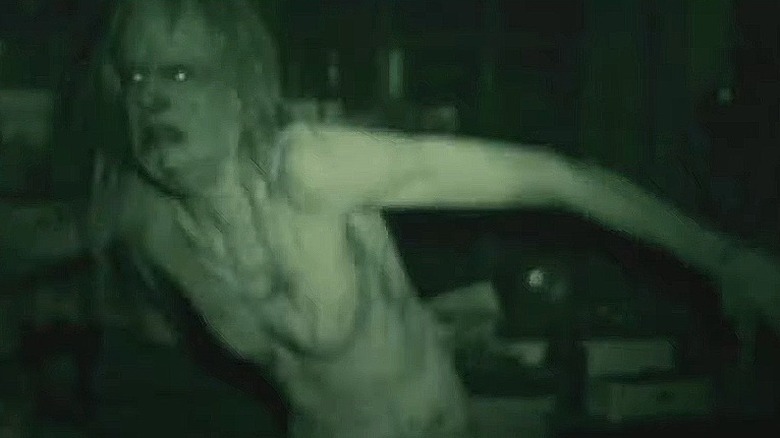The Ending Of Quarantine Explained
Following the release of the 2007 Spanish horror film "REC," 2008 saw the release of the American remake "Quarantine." The film, directed by John Erick Dowdle, tells the story of a television reporter and her cameraman who, while reporting at a local fire station, get involved in a scenario that sees them quarantined in an apartment building following the outbreak of a mysterious but devastating virus that transforms people into ravenous killers. Starring Jennifer Carpenter (of "Dexter" fame), Steve Harris, Columbus Short, and Jay Hernandez, the film has largely been unfavorably compared to its 2007 predecessor, with a 56% Tomatometer score on Rotten Tomatoes. Critic Nigel Floyd, writing for TimeOut, compared "Quarantine" to the original by describing it as, in his words, "An American remake of the Spanish horror movie '[Rec]' that adopts the same basic recipe, but removes any hint of flavour or texture, reducing cutting-edge Catalan cuisine to bland, bite-sized McNuggets."
While its place compared to its Spanish predecessor is up for debate — and it's debatable where it ranks on the all-time list of pandemic and virus movies — on its own "Quarantine" makes for a sufficiently unsettling horror experience. And before you try comparing the film to a certain other notable period of quarantine, it's worth mentioning that the inner workings of "Quarantine" reveal much more beneath the surface than one might assume.
So just what did this film do that makes your spine get such a chill? Only one way to find out –- it's time to explain the ending of "Quarantine."
Doomsday cult
In "Quarantine," after the entirety of the apartment that news reporter Angela (Jennifer Carpenter) and her cameraman Scott (Steve Harris) have been staying in has been infected by the virus, the two make it up to the building's attic, that had yet to be explored. It is here that we learn that the virus was created by a former tenant of the apartment who was a part of a doomsday cult and broke into a military facility to steal a chemical weapon.
Not much else is revealed about the virus or its full intent outside of some sparse newspaper headline clippings that are posted along the wall. One of the most important pieces we can spot, however, is a headline that brings up how all life on a remote island was eliminated by what is called the Armageddon virus. No, it's not an homage to the 1998 Michael Bay disaster film. More than likely, the virus was released to wipe out some population, or possibly even all of humanity, which isn't too hard to imagine considering that it was locked away at a military facility. With just seeing how horrific the night in the apartment was for everyone trapped there, it's utter gut-wrenching to picture what it's affect would be like on the world over.
But another detail revealed in this section could reveal another possibility, if this came to fruition.
Who's Patient Zero?
Another detail revealed at the end raises further questions about the virus' purpose. While exploring the attic further, Angela and Scott come across a decrepit young boy and old man. Despite seeming weak, they're both incredibly aggressive, lashing out and eventually killing Angela and Scott despite the duo's best efforts. As with many of the questions raised from the film, the identity of these two are left unanswered, but there are clues that could possibly lead to who they might be. Throughout the film, many of the apartment's residents talk about the sounds coming from upstairs that they're unaware of. Similarly, there is talk of the ill father of a Somalian woman left upstairs throughout the entirety of the film. Could he be the test subject, or Patient Zero, that remains upstairs and appears at the end? Or could it be the absent tenant and a child of theirs?
Either way, the effect of the virus is brought into question here. While the two here are far from the picture of health, neither seems in any apparent distress. Instead, the two — having remained in the attic for an unspecified amount of time — could very well have adapted to the effects of the virus, and even evolved, with increased speed and strength. Is it possible that the virus was seen as a way to better humanity in this twisted fashion? Or could it be there to reveal something deeper about humanity that isn't as apparent?
Showing us for the animals we are
"Quarantine" harkens back to classic survival horror films such as the horror-reshaping classic "Night of the Living Dead," where a group of strangers is trapped in tight quarters with one another and must fight to both survive from the ongoing threat while also butting heads with one another. However, with so much of the threat coming from inside the location, and significantly less revealed about the outside world, "Quarantine" has a different set of goals to show off. At one point, a veterinarian amongst the group claims that the virus shows many of the same symptoms as rabies in animals. Similarly, many of the CDC officials in the film claim that the virus began when an especially rabid dog that was traced back to the apartment attacked a host of animals in a veterinarian office.
When looking at it from this angle, "Quarantine" becomes a story about more than mere survival. Rather, by having people turn into bloodthirsty, savage zombies while the survivors fight tooth and nail to save themselves and make it out alive, it turns into a story that examines the underlying animalistic nature that we all possess deep inside. Not only what we can become taken over by a virus, but what we can turn into when faced with life-or-death situations. It's a detail that gives "Quarantine" its unnerving yet primal sensibilities that lead to its immensely gut-wrenching and harrowing tone.



